
Deerfield Beach is a city in Broward County, Florida, United States, just south of the Palm Beach County line. As of the 2020 census, the population was 86,859, making it the tenth-largest city in Broward County. It is a key suburb of the Miami metropolitan area, which was home to 6.14 million people in 2020.

Lauderhill is a city in Broward County, Florida, United States. It is a principal city of the Miami metropolitan area. As of the 2020 census, the city's population was 74,482.

Tamarac is a city in Broward County, Florida, United States. It is part of the Miami metropolitan area. At the 2020 census, the city had a population of 71,897.

Palm Springs North is an unincorporated community and census-designated place (CDP) in Miami-Dade County, Florida, United States. It is part of the Miami metropolitan area of South Florida. The population was 5,030 at the 2020 census.

Westwood Lakes is a census-designated place and unincorporated community of Miami-Dade County, Florida, United States. It is part of the Miami metropolitan area of South Florida. The population was 11,373 at the 2020 census.
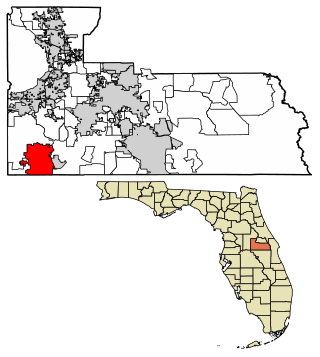
Bay Lake is a city in Orange County, Florida, United States. The population was 29 at the 2020 census. It is named after a lake that lies east of the Magic Kingdom. All four of the Walt Disney World Resort theme parks, and one of Walt Disney World's two water parks, are in Bay Lake, though all Disney parks in the region have mailing addresses in nearby Lake Buena Vista.

Boynton Beach is a city in Palm Beach County, Florida, United States. It is situated about 57 miles (92 km) north of Miami. The 2020 census recorded a population of 80,380. Boynton Beach is located in the Miami metropolitan area, which was home to 6,138,333 people at the 2020 census. The city is named after Nathan Boynton, a Civil War major and Michigan politician who became one of the first settlers in the area in 1895. Boynton Beach is located north of Delray Beach, south of Hypoluxo and Lantana, and east of Golf, while the municipalities of Briny Breezes, Gulf Stream, Manalapan, and Ocean Ridge are situated to the east across the Intracoastal Waterway.

Canal Point is a census-designated place (CDP) and unincorporated community in Palm Beach County, Florida, United States. It is part of the Miami metropolitan area of South Florida despite its local culture and location being way more similar to the Florida Heartland. Canal Point has a population of 344 people counted in the 2020 US census.
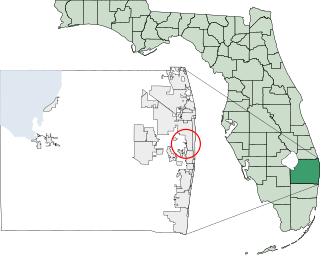
Cloud Lake is a town in Palm Beach County, Florida, United States. It is part of the Miami metropolitan area of South Florida. As of the 2020 US census, the town had a population of 134 residents.
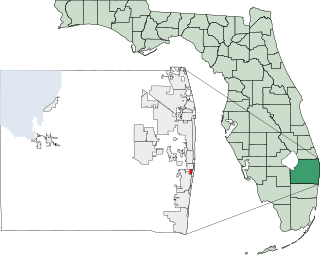
Hypoluxo is a town in Palm Beach County, Florida, United States. The town was incorporated in 1955 and is part of the Miami metropolitan area of South Florida. It is home to the Hypoluxo Scrub Natural Area, which is a protected landscape. The population was 2,687 at the 2020 US Census.

Lake Clarke Shores is a town in Palm Beach County, Florida, United States. The town is part of the Miami metropolitan area of South Florida. The 2020 census recorded a population of 3,564.

Lake Harbor is a census-designated place (CDP) in Palm Beach County, Florida, United States. It is part of the Miami metropolitan area of South Florida despite being physically and culturally closer to the Florida Heartland. The population was 49 at the 2020 US census.

Lake Worth Beach, previously named Lake Worth, is a city in east-central Palm Beach County, Florida, United States, located about 64 miles (103 km) north of Miami. The city's name is derived from the body of water along its eastern border known as the Lake Worth Lagoon, which was named for General William J. Worth, who led United States Army forces during the last part of the Second Seminole War. Lake Worth Beach is situated south of West Palm Beach, southeast of Lake Clarke Shores, east of Palm Springs, and north of Lantana, while a small section of the city also partitions the town of Palm Beach. The 2010 census recorded a population of 34,910, which increased to 42,219 in the 2020 census. Lake Worth Beach is within the Miami metropolitan area, which was home to an estimated 6,138,333 people in 2020.

Palm Beach Shores is a town in Palm Beach County, Florida, United States. The town is part of the Miami metropolitan area of South Florida. The population was 1,330 at the 2020 US census.

Palm Springs is a village in Palm Beach County, Florida, United States, situated approximately 61 mi (98 km) north of Miami. The village's name was likely derived from the resort city of Palm Springs, California. Located in the east-central part of the county, Palm Springs is situated north of Atlantis, east of Greenacres, west of Lake Clarke Shores and Lake Worth Beach, and southwest of West Palm Beach. The 2010 United States census recorded the village's population at 18,928, which increased to 26,890 in the 2020 census. Palm Springs is also located within the Miami metropolitan area of South Florida, which had a population of approximately 6,138,333 people as of 2020.

Riviera Beach is a city in Palm Beach County, Florida, United States, which was incorporated on September 29, 1922. Due to the location of its eastern boundary, it is also the easternmost municipality in the Miami metropolitan area. In the 2020 U.S. Census, the total population of Riviera Beach residents was 37,604 people.
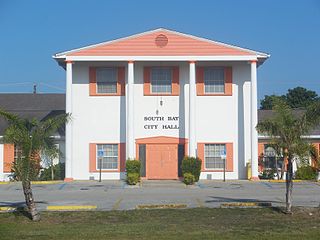
South Bay is a city in Palm Beach County, Florida, United States. It is the westernmost municipality in the South Florida metropolitan area. As of 2020, the population recorded by the U.S. Census Bureau was 4,860 residents. While the current estimates place South Bay's population in the incorporated city limits at more than 4,000 people, surrounding areas increase the population figures to 54,000 people in a 25-mile (40 km) radius and more than 1.4 million in a 50-mile (80 km) radius.
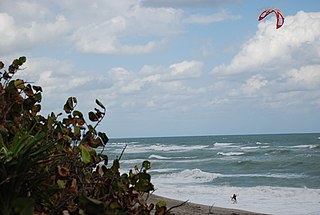
Tequesta is an incorporated village in Palm Beach County, Florida, United States. It is the northernmost municipality in the Miami metropolitan area, which according to the 2020 United States Census, had a total population of 6,138,333 South Florida residents. As of 2020, the US Census had the village's total at 6,158 of the population.

Wellington is a village just west of West Palm Beach in Palm Beach County and 66 mi (106 km) north of Miami. It is part of the Miami metropolitan area and the fifth largest municipality in Palm Beach County by population. As of the 2020 census, the village had a population of 61,637 according to the U.S. Census Bureau, making it the most populous village in the state.
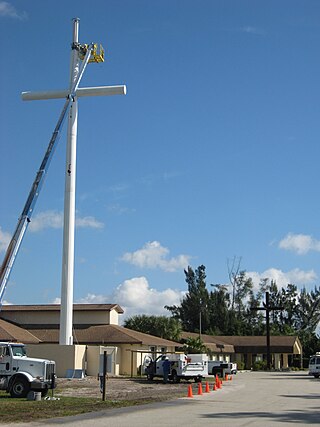
Lake Worth Corridor was a former census-designated place (CDP) and now a current unincorporated place in Palm Beach County, Florida, United States, approximately 3 miles (4.8 km) west of the city of Lake Worth Beach. The population was 18,663 at the 2000 census. The CDP was not included in the 2010 census.























